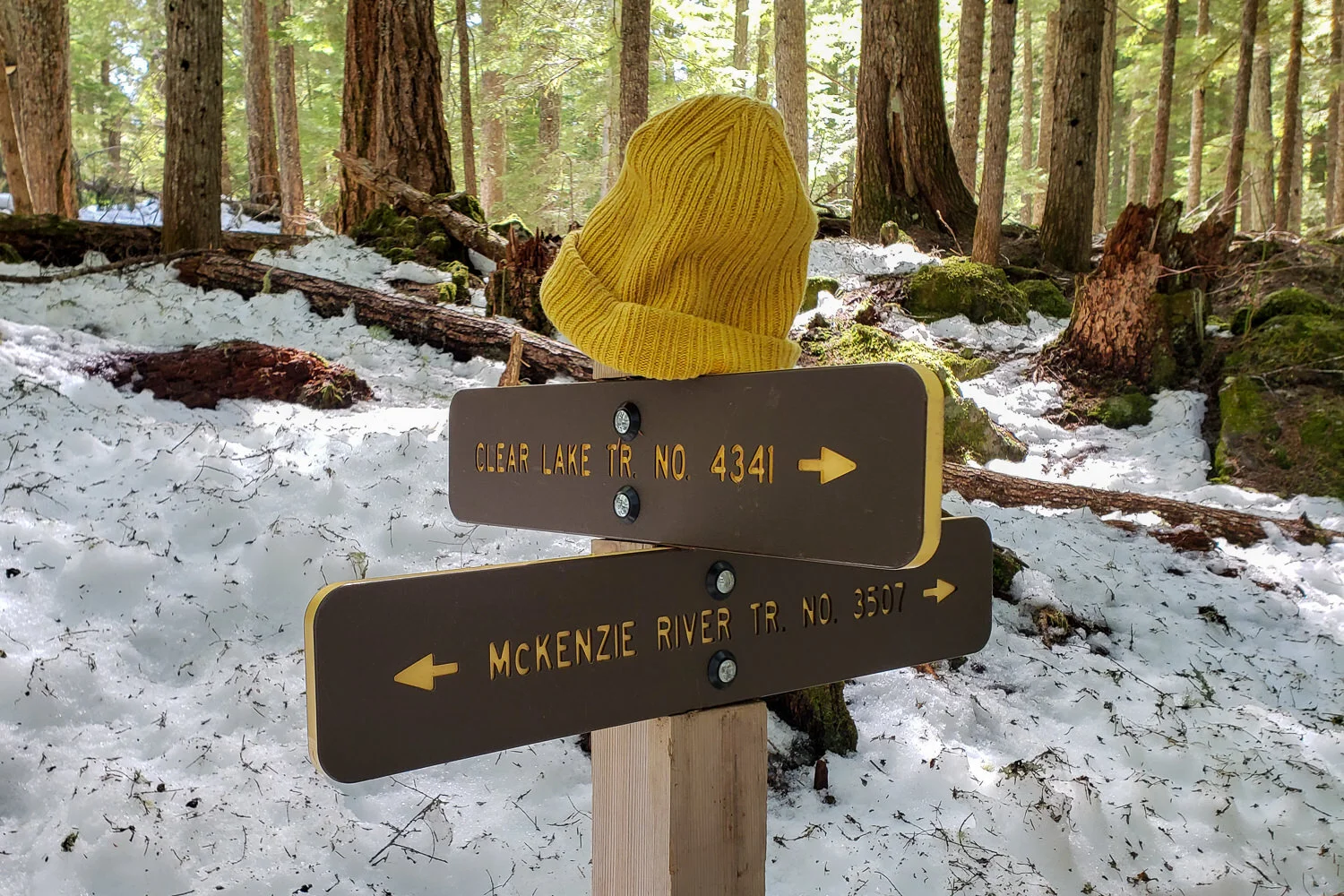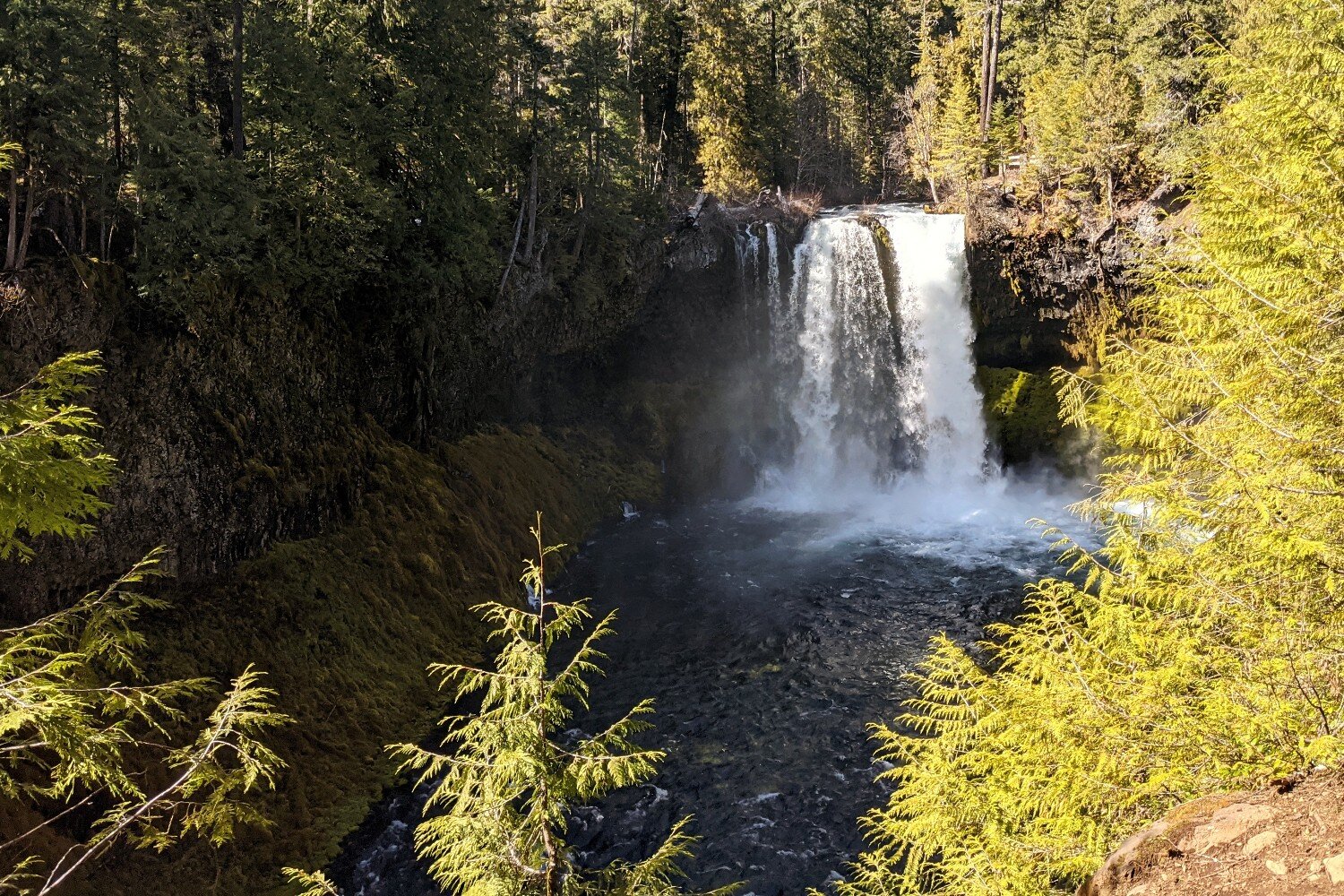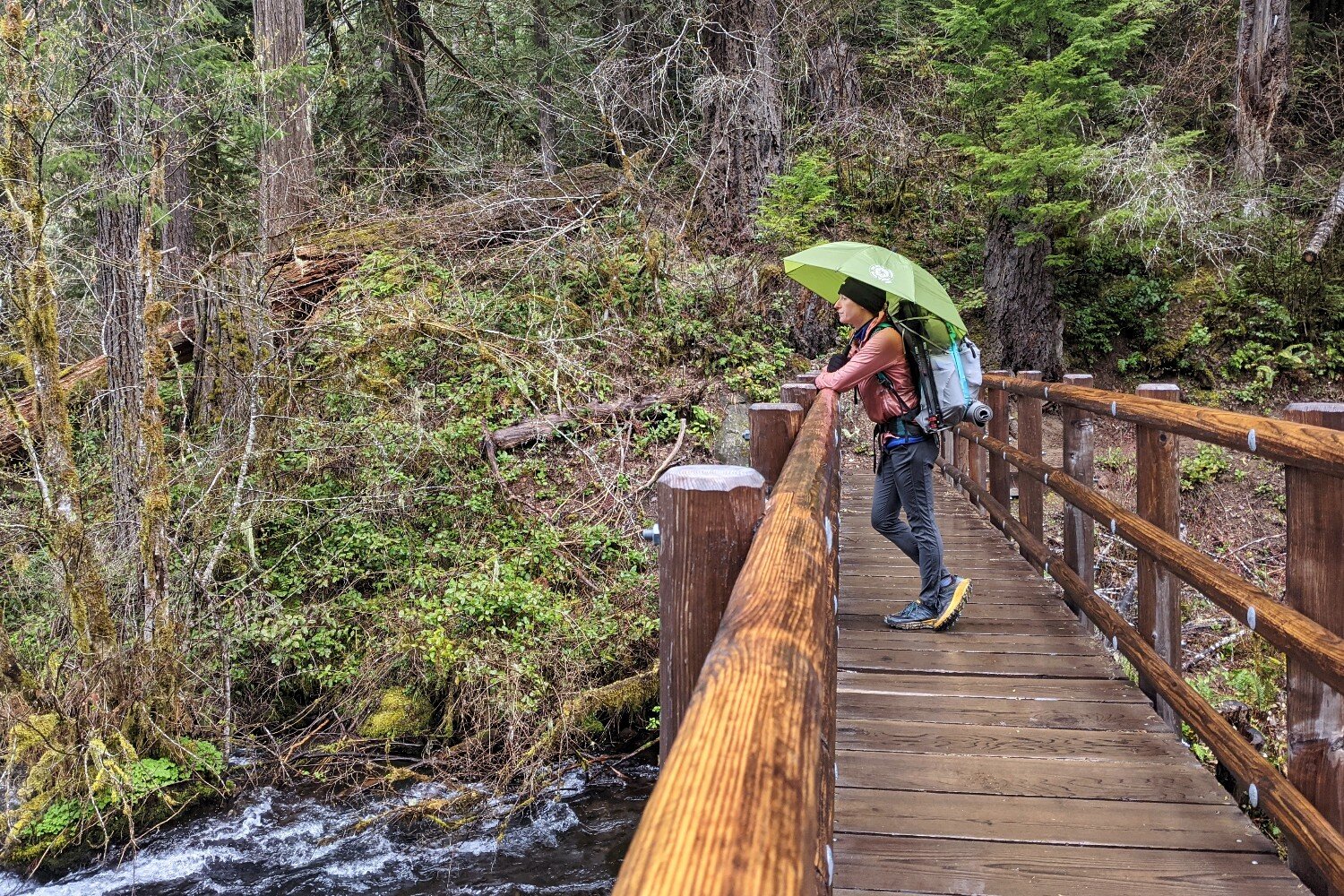McKenzie River Trail Backpacking Guide
/The McKenzie River Trail ventures through old lava flows, past views of crystal-clear blue waters, and traverses lush old-growth forests. It’s a relatively short and easy backpacking trip that you can hike over a long weekend if your time is limited, and it’s one of the few routes that’s accessible in spring and early summer in the Pacific Northwest. Plus, it offers a tempting opportunity to take a dip in a hot springs pool towards the end of your trip.
We loved not having to carry much water while hiking the McKenzie River Trail. And if you start from the Upper Trailhead, the route follows a gentle grade that’s mostly downhill. The campsites on the northern half of the trail are in developed campgrounds, which could be considered a downside (more crowds and fees), but the ease of accessibility also provides a unique opportunity for backpacking with support and the ability to use campground amenities (fire pits, toilets, etc.). It also allows plenty of flexibility as far as the length of your trip and where you enter and exit the trail.
The MRT wanders past jaw-dropping crystal-clear blue waters - The Great Spring above is the source of the McKenzie R.
Quick Facts
Distance: 27 miles (one way)
Days Needed: 2-4 days, varies
Type: Shuttle or out-and-back
Elevation Gain/Loss: 1,750 ft
Best Travel Time: Spring-Fall (Mid-April through November depending on weather)
Permits: You’ll need a Northwest Forest, local, or Interagency Pass to park at trailheads in the Willamette National Forest. There are also day use fees in some of the campgrounds along the route.
Difficulty: Easy
These areas can be crowded, but don’t miss the impressive Sahalie, Koosah, & tamolitch falls (blue pool) along the MRT.
Highlights
Crystal-clear blue lakes, springs, waterfalls, and rivers
Dramatic lava beds
Quiet old growth forest
Impressive log bridges
Easy hiking/plenty of water sources
Lots of entry/exit points
Campground amenities (fire pits, pit toilets, showers, boat ramps, etc.)
Hot springs resort on route
Well-maintained trails with excellent signage
The McKenzie River Trail is a bridge lovers paradise - check out this giant, hand-hewn beauty!
Lowlights
Limited primitive camping opportunities
At popular times, you’ll have to share the trail with mountain bikers
Blue Pool and waterfall viewpoints can be crowded
Campgrounds can be busy and costly
Belknap Hot Springs is developed (check prices for a soak and campsite here)
A shuttle or hitch hiking is necessary unless you hike out and back
The MRT weaves through gorgeous old-growth forests full of rhododendrons, ferns, and Oregon Grape.
Best time to travel
The McKenzie River Trail (MRT) has a long hiking window due to its low elevation. That means you can backpack it anytime from mid-April through the fall in most normal snow years. Snow can linger through April at the upper end of the trail, but a bit of residual snow isn’t much of an issue since the trail is so well defined. For the best experience, we recommend hitting the trail mid-spring (catch the rhododendrons in peak bloom May-July) or in the fall when you’ll have more solitude (pressure from rafters, mountain bikers, and tourists decreases). In the shoulder seasons, you’ll also have agreeable temperatures for a luxurious hot springs dip.
During the summer months the campgrounds will be open so you’ll have to pay more fees. Waterfall viewpoints will also be more crowded, but the old-growth forests and waterfront havens are still a great refuge from the heat.
We encountered some snow on the trail in early April, but it was easy to navigate and kept crowds at bay.
Difficulty
Total Distance: 27 miles
Total Elevation Gain/Loss: 1,750 ft.
Overall Difficulty: Easy
Difficulty depends on your experience, physical fitness, pack weight, & weather conditions.
We would categorize this hike as easy since the trail is well maintained with good signage, the path is well worn, and there are only a few small climbs and descents along the way. It’s a great fit for beginners and families, but it's also an excellent hike for intermediate to experienced backpackers looking for a short trip that’s not too physically demanding.
As always, the heavier your backpack is, the harder your hike will be. So do yourself a favor and pack light. For lightweight hiking tips and gear recommendations, check out our Lightweight Basics Video Series and Gear Guides.
If you start from the Upper Trailhead, the route follows a gentle grade that’s mostly downhill.
Permits
No permits are needed to hike the McKenzie River Trail, but make sure you have a Northwest Forest Pass or equivalent to park your car without issue.
A view of the Three Sisters Peaks in the distance from Clear Lake near the northern end of the mRT.
Getting There
The Mckenzie River Trail is essentially between the cities of Bend and Eugene, Oregon... which means there are LOTS of awesome dining/brewery options pre and post hike. The drive to the Trailhead is straightforward and scenic, especially if you take the backroads. There are many places to enter and exit the McKenzie River Trail since Highway 126 loosely follows the entire path. If you want to do all 27 miles, we recommend starting at the Upper McKenzie River Trail Trailhead.
From Portland, the drive takes about 2.5 hours. Take I-5 down to Salem, then take Highway 22 East. At Santiam Junction, hop on OR-20 W/ 126 S McKenzie Highway and turn left at NF-2627 to find the Upper McKenzie River Trailhead at the end of the road.
For a shorter, more leisurely trip, start at the Trail Bridge Campground and head south. There are more great riverside campsites and the best old-growth forest scenery is in the lower half of the MRT. Make sure to drive up and check out Sahalie and Koosah Falls on your way out if you choose this shorter route.
Belknap Hot Springs Resort is about 21 miles from the Upper MRT Trailhead - they offer campsites, two hot-spring fed soaking pools, lodging, & a food cart that’s occassionally open.
Shuttle Services
Cog Wild - from Bend
Many of the campsites are in developed campgrounds, but you’ll likely have them all to yourself in the spring & fall.
Maps & Guidebooks
We recommend downloading the Avenza phone app. and downloading the Willamette Cascades Recreation Map North (about $5), which covers the Mckenzie River Trail and the area surrounding.
You can also print or buy maps through the following links:
Discover Your Northwest: Detroit Ranger District Map
The McKenzie River Trail is very well maintained & it has excellent signage that’s easy to follow.
Regulations
It’s always important to practice Leave No Trace when you go into nature to protect yourself and others, wildlife, and the environment. That said, there are few hardset rules for camping in this part of the Willamette National Forest. Camping is restricted to developed campgrounds for a section along lower McKenzie River Trail and campfires should be contained to established fire rings when burning is allowed.
We consider the MRT to be an easy hike, but there are some stairs, bridges, & obstacles to navigate.
Water
There are plenty of water sources along the McKenzie River Trail including the river, springs, and lakes, so you can fill your water bottle as you go and keep your backpack lightweight. We used a Katadyn BeFree Filter with a Hydrapak Flux Bottle on this trip, to make filtering and drinking water fast and convenient. All campsites have water sources nearby, so the ability to carry 1-2 liters of water at a time is all you’ll need.
There is a three-mile section between Carmen Reservoir and Tamolitch Falls (Blue Pool), where the river disappears underground for much of the year. We recommend topping up your water before you traverse that section since harvesting water from the beaver marsh isn’t very appealing.
Side note: The McKenzie River is turbulent and dangerously cold. Use caution if you choose to cool off in the water, even during the summer months.
A Katadyn BeFree Filter & Hydrapak Flux Bottle are the perfect fast/easy filtration system when water is abundant.
Backpacking Gear: What to Pack
We prefer lightweight backpacking because it’s more comfortable and it allows us to cover more ground with less effort. For recommendations on our favorite lightweight backpacking equipment, check out the CleverHiker Gear Guide and our Top Picks page.
TENT: We used the Sea to Summit Telos TR2 and Alto TR2 on this trip. We love these tents for their great balance of livable space, low weight, and practical extras. The Telos TR2 is on our list of the Best Backpacking Tents.
SLEEPING BAG: We took the Loco Libre Ghost Pepper 20 Quilt on this trip. It’s the warmest ultralight quilt on our list of the Best Backpacking Quilts.
SLEEPING PAD: We used the Therm-A-Rest NeoAir XTherm on this trip since we did it in April and temperatures dipped to freezing at night. It provides extra insulation for cold sleepers, but it’s still lightweight and relatively compact. The XTherm is on our list of the Best Backpacking Sleeping Pads.
The Sea to Summit Telos TR2 has great balance of livable space, low weight, & practical extras for a trip on the MRT.
BACKPACK: We used the Gossamer Gear Gorilla 50 - the newest, more colorful iteration of this minimalist favorite. We love how comfortable, durable, and lightweight it is. Check out our list of the Best Backpacking Packs for our top backpack recommendations.
The Gossamer Gear Gorilla 50 is comfortable, lightweight, & has the perfect capacity for fast & light trips.
COOKING SYSTEM: We took the Soto WindMaster and the Soto Thermostack Combo Cookset. The Windmaster is quiet, powerful, and efficient, which is why it made our Best Backpacking Stoves list.
FOOD: Since this trip is fairly short, you don’t have to carry a heavy load of food, and you can afford to take along some extra luxuries if you’d like. Check out our guides on the Best Lightweight Backpacking Food, Best Freeze Dried Backpacking Meals, and Best Energy Bars for some of our go-to recommendations.
See a list of our favorite backpacking meals on our Best Freeze Dried Meals List.
FOOD STORAGE: Bear canisters aren’t required on the Mckenzie River Trail, but it’s always a good idea to store your food properly for peace of mind. We used an Ursack to keep rodents from getting their paws on our goods at night.
WATER FILTER: We took the Katadyn BeFree Filter on this trip, because it’s lightweight, convenient, and easy to use on the go - especially when you’re never far from a water source. Check it out on our list of the Best Backpacking Water Filters. We like using the BeFree in combination with the Hydrapak Flux Bottle because it’s easy to squeeze and collapses when not in use. Head over to our Best Water Bottles list to see all of the reasons we love the Flux.
The Soto WindMaster & the Soto Thermostack Combo Cookset worked great for cooking meals & hot drinks on the MRT.
SHOES OR BOOTS: We wore the Hoka One One Speedgoats for this hike. They’re supportive and comfortable for long days on the trail, and they have plenty of cushioning for the paved sections of trail that traverse the lava beds in the northern portion of the hike.
The Hoka One One Speedgoat Hiking shoes have great cushioning for hiking through the badlands.
CLOTHING: Here are some of the clothing items we used on this trip in the spring. See more of our favorite hiking/backpacking clothing in our Gear Guides.
1 Down jacket - L.L. Bean Ultralight 850 Down Men’s / Women’s
1 Pair hiking pants - Outdoor Research Ferrosi (Men’s) & Kuhl Innovair Skinny Pants (Women’s)
2-3 Pair socks - Darn Tough Micro Crew Cushion Men’s /Women’s
1 Pair base layer bottoms - Smartwool Merino 250 Base Layer Bottoms Men’s / Women’s
1 Base layer top - Smartwool Merino 250 Base Layer Quarter-Zip Top Men’s / Women’s
1 Warm hat
1 Sun hat
CAMPING CHAIR: We prefer a simple sit pad like the Gossamer Gear Thinlight Foam Pad for ultralight backpacking trips, but there are plenty of options with more support if you want to up the comfort for this leisurely hike. Check out our list of the Best Backpacking Chairs.
HEADLAMP: We took the Petzl Tikkina from our list of the Best Headlamps. It’s simple, plenty bright, and exceptionally budget friendly.
The Petzl Tikkina Headlamp is simple, easy to use, and very affordable.
MAP & COMPASS: We used the Avenza phone app. for this trip and downloaded the Willamette Cascades Recreation Map North before we left home. In addition, we always hike with a paper map (Detroit Ranger District Map) and a compass.
MULTITOOL: We brought the Victorinox Swiss Army Classic SD on this trip. It’s affordable, super handy, and weighs less than an ounce.
FIRST AID KIT: Always bring a small personalized first aid kit; we used the .5 Adventure Medical Kit.
It’s always a good idea to carry a small, lightweight first aid kit like the .5 Adventure Medical Kit.
SUN PROTECTION: Though some of the MRT is in old growth forest, you’ll still get a healthy dose of sun in more exposed portions. Sunglasses (polarized recommended), sunscreen, and spf lip balm are a must.
OTHER ITEMS:
Cash and ID
Personal toiletries
Hand sanitizer
Wet wipes
Insect repellant: a 1 oz. bottle of Picaridin will do the trick
Camera: the Sony Rx100 is our go-to camera for lightweight backpacking
Power bank - we like the Goal Zero Flip 24
A portable power bank, like the Goal Zero Flip, will keep your phone & electronics juiced up while backpacking.
If you plan to stop at Belknap Hot Spring Resort, the following items will come in handy:
Small, packable towel (towels are also available for rent at the front desk)
Ultralight camp shoes (for the showers/changing rooms)
Swimsuit or an extra pair of underwear/bra to wear in the pool
Small dry bag or sealable plastic bag (for wet clothes)
Hair tie (sleeping with wet hair will make you cold)
For more info on what to bring on your next trip, check out our Ultimate Backpacking Checklist.
McKenzie River Trail Photo Gallery














MORE INFORMATION
We hope this guide helps you plan a fun adventure along the Olympic Coast. As always, please leave a comment below if you have any recommendations, questions, or suggestions. And if you found this guide helpful, please share on social media and click the little heart button below to give us a digital high five!
For more popular CleverHiker content, check out the following links:
Disclosure: Some of the links on this page are affiliate links, which means we may receive a modest commission if purchases are made through those links. This adds no cost to our readers and helps us keep our site up and running. Our reputation is our most important asset, which is why we only provide completely honest and unbiased recommendations.































